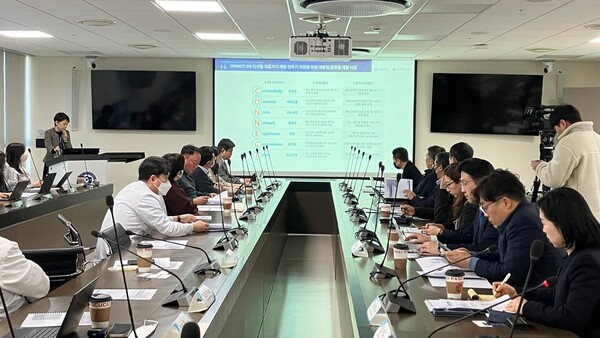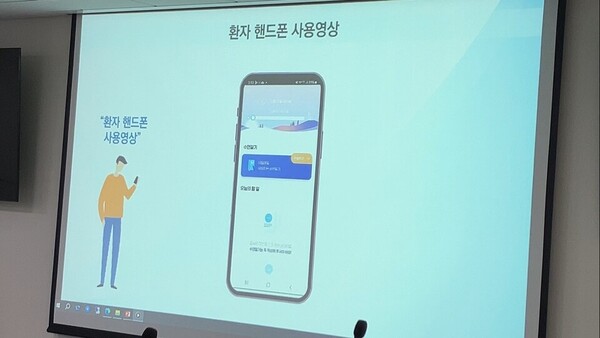
Access to medical care will soon extend into patients' daily lives through prescriptions of digital therapeutic devices (DTx). Individuals can now manage their health effectively using DTx, even without direct involvement of medical professionals.
Yonsei University Health System (YUHS) declared its dedication to prescribing DTx in earnest during a demonstration featuring cognitive therapy software for insomnia improvement. This software is founded on the "Connect-DTx" digital therapeutic device integration solution platform and was showcased at Severance Hospital on Tuesday.
Individuals can input their real-time personal data using digital therapeutic devices powered by Connect-DTx, receiving tailored prescriptions. Medical institutions can offer personalized treatment to each patient in real-time by integrating with the hospital's electronic prescription and medical record system.
From prescribing to treating insomnia patients using Somzz
For instance, a 26-year-old patient with insomnia during high school days was prescribed Somzz, a cognitive therapy software that improves insomnia, last Friday. Developed by healthcare company AimMed, Somzz provides cognitive behavioral therapy for insomnia (CBT-1), a standard treatment for chronic insomnia patients. Somzz has won approval from the Ministry of Food and Drug Safety to be Korea's first digital therapy device.

The process of prescribing a digital therapy device is as follows. A patient who visits the hospital for the first time is screened for insomnia symptoms and is prescribed a digital therapy device through patient consent. Upon receipt of the doctor's prescription, the patient's digital therapy device prescription information is automatically sent to the platform and delivered to the patient's mobile phone. The patient then installs the application and authenticates themselves to use the digital therapy device app.
Patients can conveniently communicate with government agencies responsible for insurance claims and audits. Government agencies, including the National Health Insurance Service and the Ministry of Food and Drug Safety, can monitor the effectiveness of the prescribed digital therapeutic device in real-time and the results of clinical trials. Developers of digital therapeutic devices can easily connect with medical organizations on the platform.
Aims to secure primary and secondary care institutions based on Connect-DTx by year-end
Connect-DTx is why digital therapeutic devices have been established in the medical system and the infrastructure to ensure user convenience and safety for medical institutions, government agencies, and patients.
In 2022, YUHS received 7.8 billion won ($5.8 million) from the Ministry of Trade, Industry and Energy to develop Connect-DTx. This digital therapeutic device platform connects and utilizes information from PHI Digital Healthcare and digital therapeutic device users, treatment services, products, and places.
Based on Connect-DTx, YUHS plans to link the platform to the medical record prescription systems of six hospitals this year – the Catholic University of Korea Seoul St. Mary's Hospital, Seoul National University Bundang Hospital, SMG-SNU Boramae Medical Center, Wonju Severance Christian Hospital, Yongin Severance Hospital, and Gangnam Severance Hospital.
In addition, medical institutions, technology companies, and government agencies connected to Connect-DTx plan to expand the development of digital treatment devices for various diseases such as dementia, Parkinson's disease, and smoking cessation, in addition to insomnia treatment devices, by utilizing medical big data built on the platform.
Above all, YUHS plans to expand access to treatment by expanding digital treatment devices to primary and secondary medical institutions. It will link its platform with six large hospitals and expand its services through collaboration with EMR (electronic medical record) companies in primary and secondary medical institutions, such as BIT Computer and MediBloc.
"We're not just contemplating the expansion of DTx products; we're also considering expansion by type of medical institution," said You Seng-chan, technical director of PHI Digital Healthcare and a professor of biomedical system information at Yonsei University College of Medicine. "If the role of R&D is important in tertiary hospitals, I think the spread of services will be made in primary and secondary medical institutions."
You added that their goal is to connect with primary and secondary EMRs so that DTx services can be more conveniently accessed by patients in primary and secondary institutions rather than being used only in tertiary institutions.
Lim Joon-seok, head of the Digital Health Office at YUHS, said, "The development of Connect-DTx, a digital therapeutic device platform, enables customized treatment for patients as well as user-friendly and safe medical data utilization for medical institutions, government departments, and digital therapeutic device development companies."
Lim added that YUHS expects it to serve as pump-priming water for the advanced medical era based on big data that systematically analyzes patients' daily algorithms and treatment patterns that are difficult to check in the clinic.
Related articles
- [Top 10 Healthcare News in 2023 ③] The evolution of digital therapeutics in 2023
- AimMed challenges to develop DTx for Galaxy Watch
- Number of DTx license applications since April remains ‘zero’
- Welt, Aimmed face delays in launching Korea's first approved DTx devices
- Drug regulator increases DTx budget by ₩2.3 billion
- Severance Hospital develops AI-based sepsis diagnosis
- YUHS partners with KURE.AI Therapeutics for cell therapy development
- Yongin Severance Hospital starts prescribing digital insomnia therapy Somzz
- Severance Hospital conducts 1st successful electroporation therapy for liver cancer
- 3-year-old heart transplant survivor discharged from Severance Hospital
- Plant-based hemostatic powder shows promise in treating gastrointestinal bleeding
- Professor Keum appointed as new YUHS chief
- Regulatory roadblocks impede growth of digital therapeutics industry in Korea
- Experts lament obstacles to expanding DTx prescriptions
- JYP Entertainment donates ₩500 million to Yonsei University Health System to support underprivileged children

